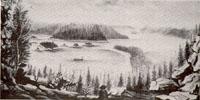
|
A Cautious Beginning: The Court of Civil Jurisdiction 1791 by Christopher English and Christopher Curran The Judicature Act, 1791: A Framework for the Future As a gauge of continuity the first Chief Judge was John Reeves, legal adviser to the Board of Trade. However, the two months he spent on the Island in 1791 convinced him that the new Act was inadequate. It was the sole civil court during the fishing season and it had no criminal jurisdiction. Complaints surfaced about the venality of the sheriff and the choice of a naval officer and Graham as assessors. Finally, the court could not deal with the flood of petitions consequent upon bankruptcies totalling £170,000, and outstanding writs to a total of £25,000, from St. John's alone. Forty per cent of the actions were now between merchants. Only a fraction of the cases were heard that year.37 Reeves' Report of December 1791 set the scene for an amended Act the following year. That continuity rather than change was envisioned was evident when the new bill was accompanied by a "regulating" bill to tighten up enforcement of Palliser's Act.38 However, the incompatibility of the two must have been recognized because the second was not proceeded with and is lost from sight.
The new Act was doubly important. It markedly expanded the Act of 1791 and accelerated the trend towards reconciling statute with 18th century practice. To the civil jurisdiction of the now "Supreme Court" was added a criminal one "with full power and authority to hold plea of all crimes and misdemeanours . . . in the same manner as . . . [in] England" (s. 1). In recognition of the force of local circumstance and conditions, however, the court's jurisdiction would be exercised "according to the law of England, so far as the same can be applied to suits and complaints arising in the islands" (s. 1). The powers, salaries and discretion to appoint officers and staff of the Act of 1791 remained unchanged (s. 3). A second bow to local practice lay in the Governor's power, on the advice of the Chief Justice (the term now employed), "to institute courts of civil jurisdiction . . . called surrogate courts . . . as occasion shall require" (s. 2). A third statutory innovation, reaching back to Oyer and Terminer, extended to civil litigants the right to request a jury trial in cases over £10. The Chief Justice would summon 24 citizens from which to draw a jury of 12. If a jury could not be formed the governor or his surrogates could appoint "two proper persons to be assessors" to sit with the Chief Justice or surrogate judge (s. 4). Appeals from the Surrogate Courts on judgment over £40 lay to the Supreme Court upon a surety for double the award being registered with the Surrogate Court within two days of judgment. Appeals lay from the Supreme Court to the Privy Council on awards over £100 on the same terms as in 1791. |
||||||||||||||||
 |
||||||||||||||||
